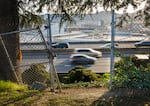
FILE - The I-5 freeway is seen through the fencing at the back of Harriet Tubman Middle School in North Portland, April 9, 2021.
Kristyna Wentz-Graff / OPB
As plans to widen and cover a section of Interstate 5 through Portland’s Rose Quarter move forward, community groups and anti-highway advocates are once again suing to stymie the long-contentious project.
Five organizations filed suit against state transportation officials in Multnomah County last week, arguing that the latest version of the nearly $2 billion project on a two-mile stretch of Interstate 5 through the Rose Quarter flies in the face of growth plans adopted by the city of Portland and Metro.
The groups — No More Freeways, Neighbors for Clean Air, the Eliot Neighborhood Association, Bikeloud, and Families for Safe Streets — are asking a judge to halt the project until it complies with those plans. They argue the push to widen the freeway “advances a plan that will adversely affect the climate, air quality, traffic congestion, and the daily lives of Portland residents.”
The suit is part of a multipronged war that No More Freeways and its allies have waged against the Rose Quarter project for the last seven years. The group previously filed suit in both state and federal court over a previous iteration of the plan, but those lawsuits were dismissed in 2022, after state officials scrapped the configuration because of public pushback.
Now the Oregon Department of Transportation is proceeding with a far grander vision: Not only will it add two auxiliary lanes to the interstate in an effort to ease congestion through the Rose Quarter, it will also build a “cap” that covers the freeway and reconnects a piece of the historically Black Albina Neighborhood severed when I-5 was constructed.
Previous versions of the project included freeway covers, but those design plans didn’t allow for structures to be built atop the covers. The latest plan does, but that, along with inflation and years of delay, has driven costs upward.
The more robust covers were a major addition pushed by the nonprofit Albina Vision Trust. The change was a central reason Portland city officials signed back onto the Rose Quarter project in 2022, after earlier ordering city staff to stop working on it.
The revamped project has been picking up momentum. In March, the Federal Highway Administration issued a “finding of no significant impact” that will allow plans to proceed, and the federal government also announced it would award $450 million to help cap the freeway.
Related: Oregonians once feared their state would be wrecked by out-of-control, sprawling development
ODOT issued its own findings that the project complies with all relevant plans that control how Portland can grow.
It’s those findings that the new lawsuit takes issue with. The plaintiffs say the project actually runs afoul of both a Central City 2035 plan adopted by the city in 2018 and a regional transportation plan adopted by Metro last year.
Among their points:
- That the city’s plan requires that “congestion pricing” — tolls that combat traffic jams by charging drivers more at peak driving times — be implemented in conjunction with the Rose Quarter project. Gov. Tina Kotek recently scrapped a program that would have instituted congestion pricing on Portland freeways. “There is no plan,” said Chris Smith, a member of No More Freeways and a named plaintiff in the lawsuit. “They can’t meet the city’s condition.”
- That the project would widen the interstate far more than required for the two additional merging lanes ODOT has promised. “This level of extra paving would also allow for at least six additional lanes of traffic, and possibly more, which is far beyond what has been proposed, and far more than has been accounted for in any environmental or compliance analysis,” the lawsuit says.
- That ODOT has not demonstrated that the congestion it is seeking to ease could not be solved by strategies besides adding the so-called auxiliary lanes, as required under Metro’s plans.
A spokesperson for ODOT said Tuesday that the agency would not comment on active litigation.
ODOT instead noted that it had recently received federal grant money and permissions to move forward, and called the project “an opportunity to not only improve our state’s worst bottleneck and highest crash site but to also reconnect the Albina neighborhood and support a greater vision for the historic heart of Portland’s Black community.” The project area encompasses a stretch of I-5 where two other major freeways — interstates 405 and 84 — merge into the main artery of the north-south freeway.
Related: A plan to toll Portland highways is dead, but congestion pricing is still on the table
The lawsuit filed Friday is just a start, said Smith with No More Freeways. The group also plans to sue in federal court, as it did with the earlier proposal.
Lawsuits are not the only thing standing in the way of the Rose Quarter project. Mired in a funding crisis, ODOT needs to figure out how to pay for the project – particularly in light of Kotek’s decision to scrap tolls. The agency has said the project could cost up to $1.9 billion, the majority of which it does not have.
State lawmakers approved some funding in 2017, but that money was eventually transferred to another project. Meanwhile, the price of the Rose Quarter effort has more than quadrupled.
Agency officials told the Oregon Transportation Commission last week they hoped to apply for another federal grant, this one for $750 million. But securing that money would require ODOT to pony up $250 million, and the agency is already short $300 million for another major Portland-area effort: seismic strengthening on the Abernethy Bridge, where I-205 crosses the Willamette River.
